Concepts in Wireless Networking: Technologies and Protocols
VerifiedAdded on 2023/06/08
|9
|2256
|230
Report
AI Summary
This report provides a comprehensive overview of wireless networking concepts, focusing on antenna technologies and network protocols. It begins by examining various antenna types, including Yagi, horn, and cellular antennas, detailing their strengths and weaknesses in different communication scenarios. The report then discusses wireless network protocols such as LTE, Wi-Fi, and Bluetooth, highlighting their features, advantages, and security challenges. Furthermore, it includes a critical reflection on software-defined wireless networks (SDN), drawing insights from case studies on SDN architecture and its role in improving network efficiency and virtualization. The report concludes by emphasizing the significance of SDN in the evolution of 5G networks and mobile edge computing (MEC). Desklib offers this document along with a wealth of study resources to aid students in their academic pursuits.
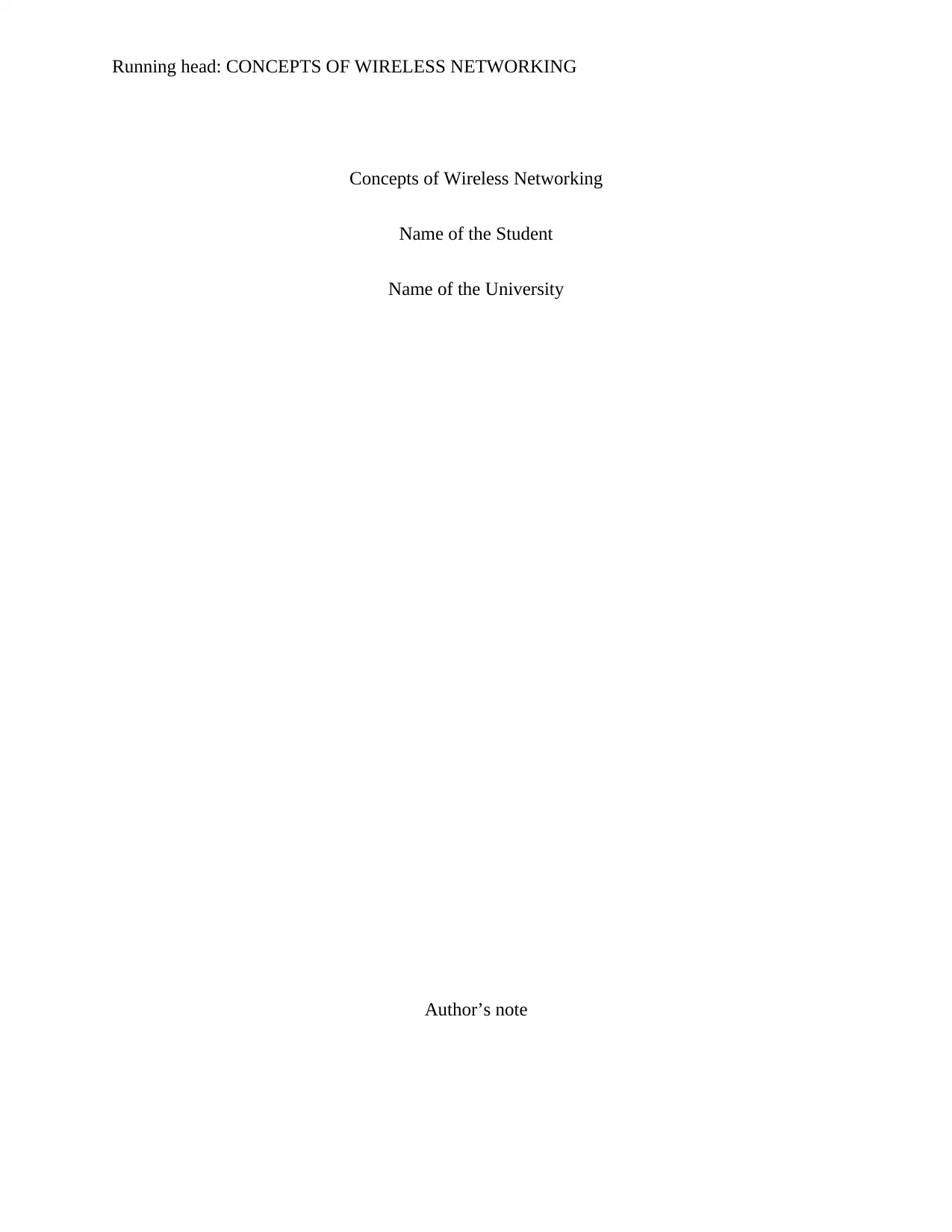
Running head: CONCEPTS OF WIRELESS NETWORKING
Concepts of Wireless Networking
Name of the Student
Name of the University
Author’s note
Concepts of Wireless Networking
Name of the Student
Name of the University
Author’s note
Paraphrase This Document
Need a fresh take? Get an instant paraphrase of this document with our AI Paraphraser
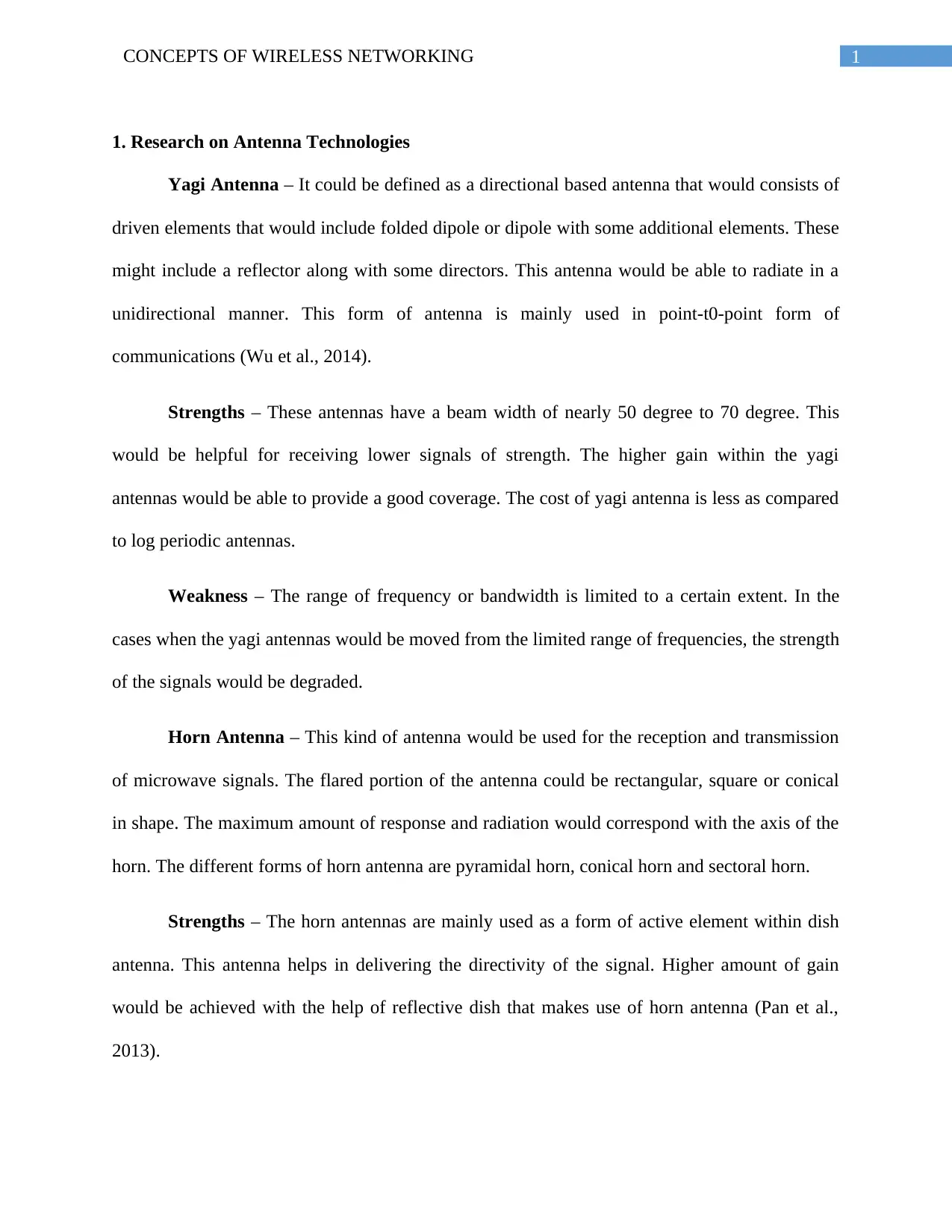
1CONCEPTS OF WIRELESS NETWORKING
1. Research on Antenna Technologies
Yagi Antenna – It could be defined as a directional based antenna that would consists of
driven elements that would include folded dipole or dipole with some additional elements. These
might include a reflector along with some directors. This antenna would be able to radiate in a
unidirectional manner. This form of antenna is mainly used in point-t0-point form of
communications (Wu et al., 2014).
Strengths – These antennas have a beam width of nearly 50 degree to 70 degree. This
would be helpful for receiving lower signals of strength. The higher gain within the yagi
antennas would be able to provide a good coverage. The cost of yagi antenna is less as compared
to log periodic antennas.
Weakness – The range of frequency or bandwidth is limited to a certain extent. In the
cases when the yagi antennas would be moved from the limited range of frequencies, the strength
of the signals would be degraded.
Horn Antenna – This kind of antenna would be used for the reception and transmission
of microwave signals. The flared portion of the antenna could be rectangular, square or conical
in shape. The maximum amount of response and radiation would correspond with the axis of the
horn. The different forms of horn antenna are pyramidal horn, conical horn and sectoral horn.
Strengths – The horn antennas are mainly used as a form of active element within dish
antenna. This antenna helps in delivering the directivity of the signal. Higher amount of gain
would be achieved with the help of reflective dish that makes use of horn antenna (Pan et al.,
2013).
1. Research on Antenna Technologies
Yagi Antenna – It could be defined as a directional based antenna that would consists of
driven elements that would include folded dipole or dipole with some additional elements. These
might include a reflector along with some directors. This antenna would be able to radiate in a
unidirectional manner. This form of antenna is mainly used in point-t0-point form of
communications (Wu et al., 2014).
Strengths – These antennas have a beam width of nearly 50 degree to 70 degree. This
would be helpful for receiving lower signals of strength. The higher gain within the yagi
antennas would be able to provide a good coverage. The cost of yagi antenna is less as compared
to log periodic antennas.
Weakness – The range of frequency or bandwidth is limited to a certain extent. In the
cases when the yagi antennas would be moved from the limited range of frequencies, the strength
of the signals would be degraded.
Horn Antenna – This kind of antenna would be used for the reception and transmission
of microwave signals. The flared portion of the antenna could be rectangular, square or conical
in shape. The maximum amount of response and radiation would correspond with the axis of the
horn. The different forms of horn antenna are pyramidal horn, conical horn and sectoral horn.
Strengths – The horn antennas are mainly used as a form of active element within dish
antenna. This antenna helps in delivering the directivity of the signal. Higher amount of gain
would be achieved with the help of reflective dish that makes use of horn antenna (Pan et al.,
2013).
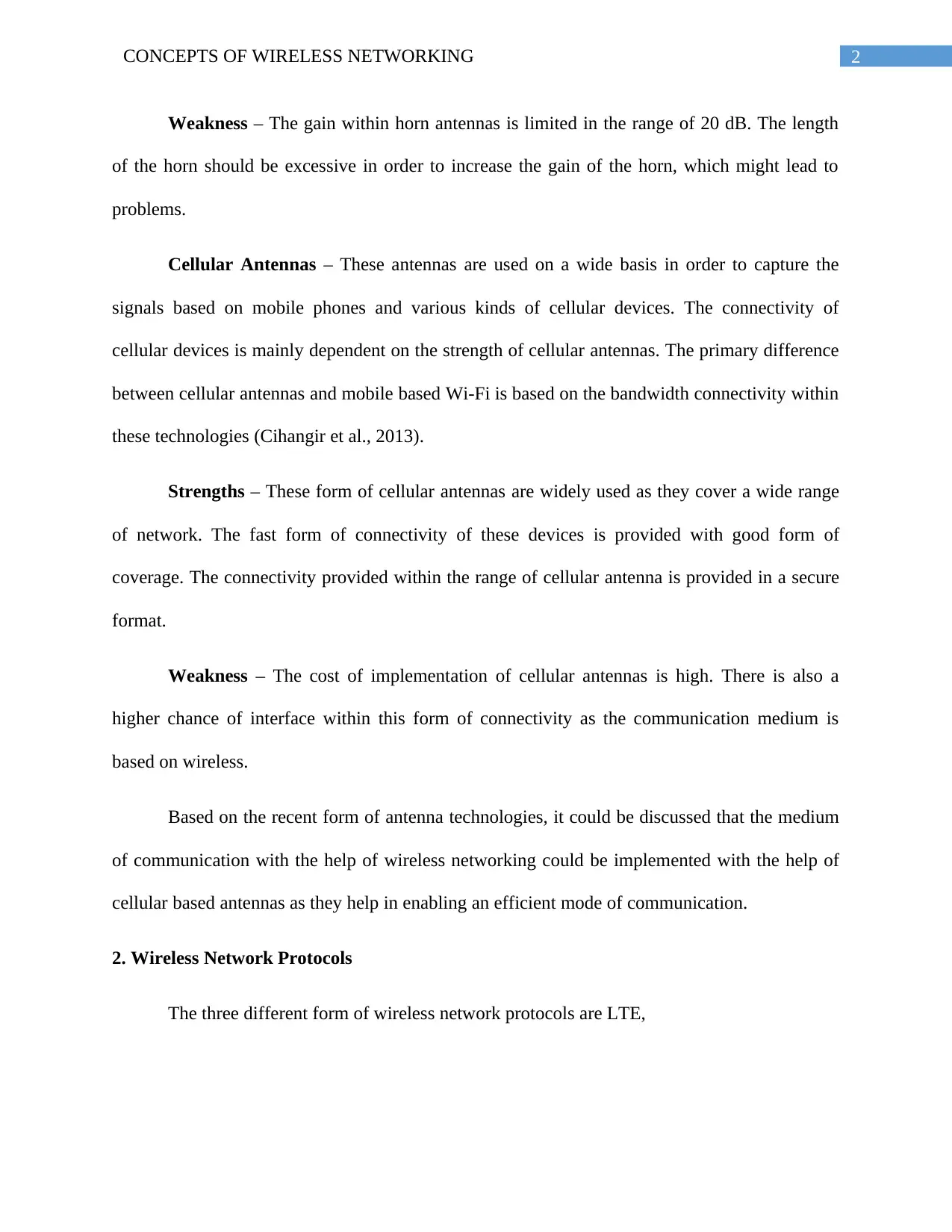
2CONCEPTS OF WIRELESS NETWORKING
Weakness – The gain within horn antennas is limited in the range of 20 dB. The length
of the horn should be excessive in order to increase the gain of the horn, which might lead to
problems.
Cellular Antennas – These antennas are used on a wide basis in order to capture the
signals based on mobile phones and various kinds of cellular devices. The connectivity of
cellular devices is mainly dependent on the strength of cellular antennas. The primary difference
between cellular antennas and mobile based Wi-Fi is based on the bandwidth connectivity within
these technologies (Cihangir et al., 2013).
Strengths – These form of cellular antennas are widely used as they cover a wide range
of network. The fast form of connectivity of these devices is provided with good form of
coverage. The connectivity provided within the range of cellular antenna is provided in a secure
format.
Weakness – The cost of implementation of cellular antennas is high. There is also a
higher chance of interface within this form of connectivity as the communication medium is
based on wireless.
Based on the recent form of antenna technologies, it could be discussed that the medium
of communication with the help of wireless networking could be implemented with the help of
cellular based antennas as they help in enabling an efficient mode of communication.
2. Wireless Network Protocols
The three different form of wireless network protocols are LTE,
Weakness – The gain within horn antennas is limited in the range of 20 dB. The length
of the horn should be excessive in order to increase the gain of the horn, which might lead to
problems.
Cellular Antennas – These antennas are used on a wide basis in order to capture the
signals based on mobile phones and various kinds of cellular devices. The connectivity of
cellular devices is mainly dependent on the strength of cellular antennas. The primary difference
between cellular antennas and mobile based Wi-Fi is based on the bandwidth connectivity within
these technologies (Cihangir et al., 2013).
Strengths – These form of cellular antennas are widely used as they cover a wide range
of network. The fast form of connectivity of these devices is provided with good form of
coverage. The connectivity provided within the range of cellular antenna is provided in a secure
format.
Weakness – The cost of implementation of cellular antennas is high. There is also a
higher chance of interface within this form of connectivity as the communication medium is
based on wireless.
Based on the recent form of antenna technologies, it could be discussed that the medium
of communication with the help of wireless networking could be implemented with the help of
cellular based antennas as they help in enabling an efficient mode of communication.
2. Wireless Network Protocols
The three different form of wireless network protocols are LTE,
⊘ This is a preview!⊘
Do you want full access?
Subscribe today to unlock all pages.

Trusted by 1+ million students worldwide
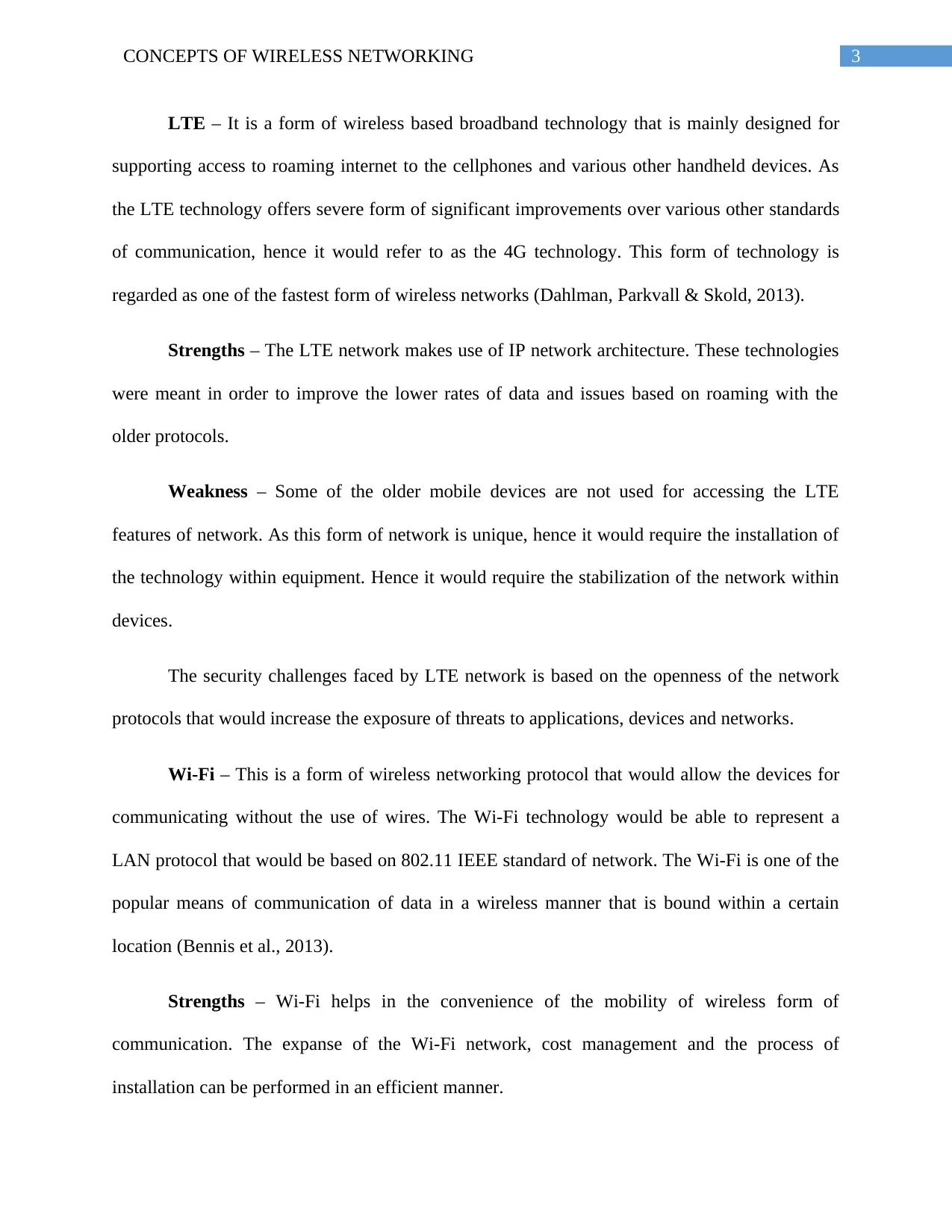
3CONCEPTS OF WIRELESS NETWORKING
LTE – It is a form of wireless based broadband technology that is mainly designed for
supporting access to roaming internet to the cellphones and various other handheld devices. As
the LTE technology offers severe form of significant improvements over various other standards
of communication, hence it would refer to as the 4G technology. This form of technology is
regarded as one of the fastest form of wireless networks (Dahlman, Parkvall & Skold, 2013).
Strengths – The LTE network makes use of IP network architecture. These technologies
were meant in order to improve the lower rates of data and issues based on roaming with the
older protocols.
Weakness – Some of the older mobile devices are not used for accessing the LTE
features of network. As this form of network is unique, hence it would require the installation of
the technology within equipment. Hence it would require the stabilization of the network within
devices.
The security challenges faced by LTE network is based on the openness of the network
protocols that would increase the exposure of threats to applications, devices and networks.
Wi-Fi – This is a form of wireless networking protocol that would allow the devices for
communicating without the use of wires. The Wi-Fi technology would be able to represent a
LAN protocol that would be based on 802.11 IEEE standard of network. The Wi-Fi is one of the
popular means of communication of data in a wireless manner that is bound within a certain
location (Bennis et al., 2013).
Strengths – Wi-Fi helps in the convenience of the mobility of wireless form of
communication. The expanse of the Wi-Fi network, cost management and the process of
installation can be performed in an efficient manner.
LTE – It is a form of wireless based broadband technology that is mainly designed for
supporting access to roaming internet to the cellphones and various other handheld devices. As
the LTE technology offers severe form of significant improvements over various other standards
of communication, hence it would refer to as the 4G technology. This form of technology is
regarded as one of the fastest form of wireless networks (Dahlman, Parkvall & Skold, 2013).
Strengths – The LTE network makes use of IP network architecture. These technologies
were meant in order to improve the lower rates of data and issues based on roaming with the
older protocols.
Weakness – Some of the older mobile devices are not used for accessing the LTE
features of network. As this form of network is unique, hence it would require the installation of
the technology within equipment. Hence it would require the stabilization of the network within
devices.
The security challenges faced by LTE network is based on the openness of the network
protocols that would increase the exposure of threats to applications, devices and networks.
Wi-Fi – This is a form of wireless networking protocol that would allow the devices for
communicating without the use of wires. The Wi-Fi technology would be able to represent a
LAN protocol that would be based on 802.11 IEEE standard of network. The Wi-Fi is one of the
popular means of communication of data in a wireless manner that is bound within a certain
location (Bennis et al., 2013).
Strengths – Wi-Fi helps in the convenience of the mobility of wireless form of
communication. The expanse of the Wi-Fi network, cost management and the process of
installation can be performed in an efficient manner.
Paraphrase This Document
Need a fresh take? Get an instant paraphrase of this document with our AI Paraphraser

4CONCEPTS OF WIRELESS NETWORKING
Weakness – This form of wireless mode of communication could be hacked in an easy
manner. A simple leak within the access to password would lead to gain access to important
credentials within the data of an individual. Hence the security of the Wi-Fi networks are not
fully secure. The range of the networks are not as high (Duarte et al., 2014).
The security challenges faced by Wi-Fi networks are based on Denial of Service,
Interception of Data, Phishing attacks and many others.
Bluetooth – This is a form of technology based on radio communication that would help
in enabling short distance and low-paper wireless based networking that would occur within
computers, phones and various other forms of network connected devices (Wang et al., 2013).
The technology of Bluetooth was designed in order to support networking within portable
network connected devices that would run on the use of batteries. Bluetooth technology could be
used in a wide number of devices such as smartphones, wireless keyboards, wireless speakers
and computers.
Strengths – The main strengths of Bluetooth enabled technologies is that they are
cheaper and have an easier process of installation. The technology helps in the convenience of
the connection of different mobile devices. This is also an efficient form of wireless mode of
communication.
Weakness – As the communication mode of Bluetooth technologies is based on wireless
hence they have severe chances to get hacked. Cell phones are prone to get infected by viruses if
the bluetooth technologies get hacked (Heydon, 2013).
The security challenges in relation with Bluetooth technologies is based on authentication
procedures based on the mobile devices. The aspect of confidentiality and authorization of
Weakness – This form of wireless mode of communication could be hacked in an easy
manner. A simple leak within the access to password would lead to gain access to important
credentials within the data of an individual. Hence the security of the Wi-Fi networks are not
fully secure. The range of the networks are not as high (Duarte et al., 2014).
The security challenges faced by Wi-Fi networks are based on Denial of Service,
Interception of Data, Phishing attacks and many others.
Bluetooth – This is a form of technology based on radio communication that would help
in enabling short distance and low-paper wireless based networking that would occur within
computers, phones and various other forms of network connected devices (Wang et al., 2013).
The technology of Bluetooth was designed in order to support networking within portable
network connected devices that would run on the use of batteries. Bluetooth technology could be
used in a wide number of devices such as smartphones, wireless keyboards, wireless speakers
and computers.
Strengths – The main strengths of Bluetooth enabled technologies is that they are
cheaper and have an easier process of installation. The technology helps in the convenience of
the connection of different mobile devices. This is also an efficient form of wireless mode of
communication.
Weakness – As the communication mode of Bluetooth technologies is based on wireless
hence they have severe chances to get hacked. Cell phones are prone to get infected by viruses if
the bluetooth technologies get hacked (Heydon, 2013).
The security challenges in relation with Bluetooth technologies is based on authentication
procedures based on the mobile devices. The aspect of confidentiality and authorization of
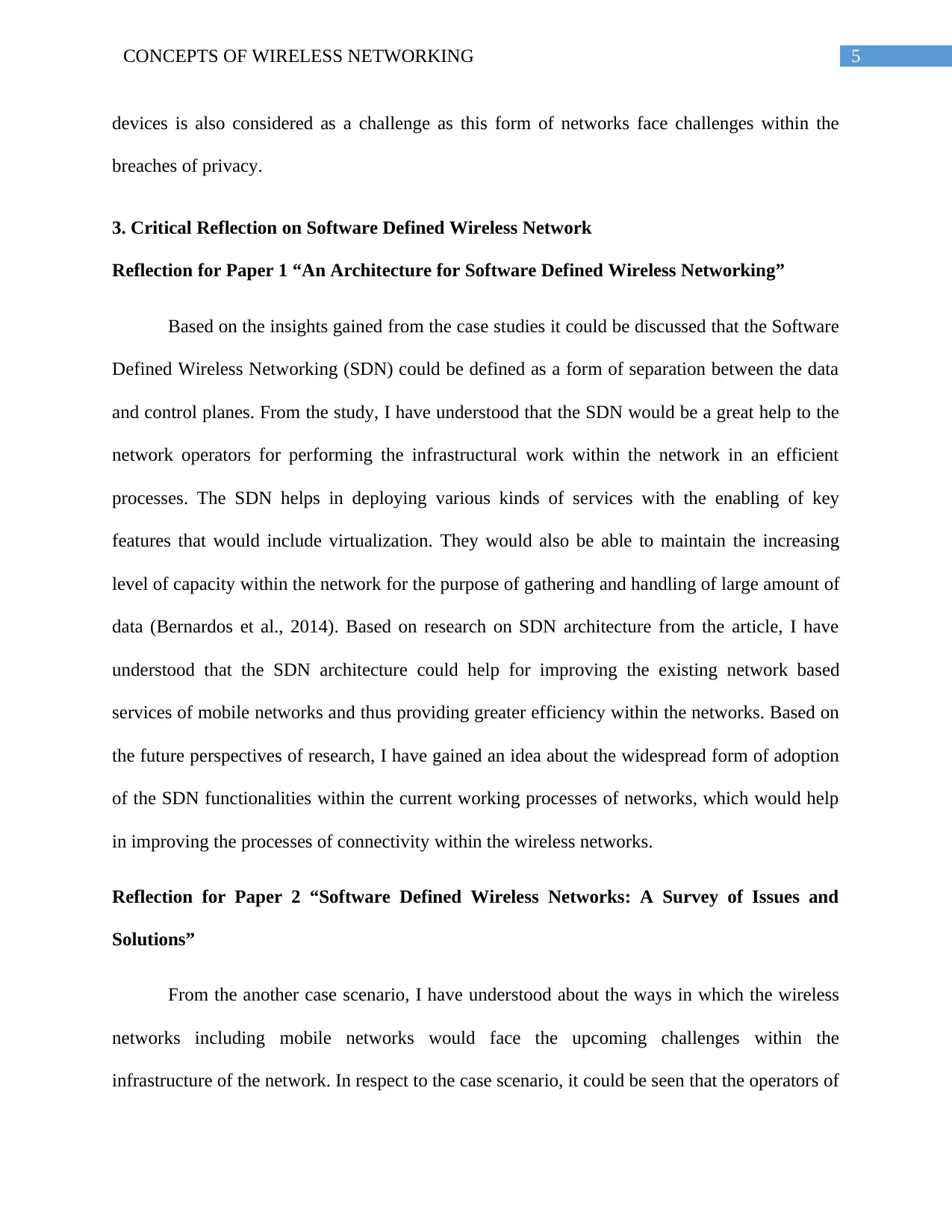
5CONCEPTS OF WIRELESS NETWORKING
devices is also considered as a challenge as this form of networks face challenges within the
breaches of privacy.
3. Critical Reflection on Software Defined Wireless Network
Reflection for Paper 1 “An Architecture for Software Defined Wireless Networking”
Based on the insights gained from the case studies it could be discussed that the Software
Defined Wireless Networking (SDN) could be defined as a form of separation between the data
and control planes. From the study, I have understood that the SDN would be a great help to the
network operators for performing the infrastructural work within the network in an efficient
processes. The SDN helps in deploying various kinds of services with the enabling of key
features that would include virtualization. They would also be able to maintain the increasing
level of capacity within the network for the purpose of gathering and handling of large amount of
data (Bernardos et al., 2014). Based on research on SDN architecture from the article, I have
understood that the SDN architecture could help for improving the existing network based
services of mobile networks and thus providing greater efficiency within the networks. Based on
the future perspectives of research, I have gained an idea about the widespread form of adoption
of the SDN functionalities within the current working processes of networks, which would help
in improving the processes of connectivity within the wireless networks.
Reflection for Paper 2 “Software Defined Wireless Networks: A Survey of Issues and
Solutions”
From the another case scenario, I have understood about the ways in which the wireless
networks including mobile networks would face the upcoming challenges within the
infrastructure of the network. In respect to the case scenario, it could be seen that the operators of
devices is also considered as a challenge as this form of networks face challenges within the
breaches of privacy.
3. Critical Reflection on Software Defined Wireless Network
Reflection for Paper 1 “An Architecture for Software Defined Wireless Networking”
Based on the insights gained from the case studies it could be discussed that the Software
Defined Wireless Networking (SDN) could be defined as a form of separation between the data
and control planes. From the study, I have understood that the SDN would be a great help to the
network operators for performing the infrastructural work within the network in an efficient
processes. The SDN helps in deploying various kinds of services with the enabling of key
features that would include virtualization. They would also be able to maintain the increasing
level of capacity within the network for the purpose of gathering and handling of large amount of
data (Bernardos et al., 2014). Based on research on SDN architecture from the article, I have
understood that the SDN architecture could help for improving the existing network based
services of mobile networks and thus providing greater efficiency within the networks. Based on
the future perspectives of research, I have gained an idea about the widespread form of adoption
of the SDN functionalities within the current working processes of networks, which would help
in improving the processes of connectivity within the wireless networks.
Reflection for Paper 2 “Software Defined Wireless Networks: A Survey of Issues and
Solutions”
From the another case scenario, I have understood about the ways in which the wireless
networks including mobile networks would face the upcoming challenges within the
infrastructure of the network. In respect to the case scenario, it could be seen that the operators of
⊘ This is a preview!⊘
Do you want full access?
Subscribe today to unlock all pages.

Trusted by 1+ million students worldwide
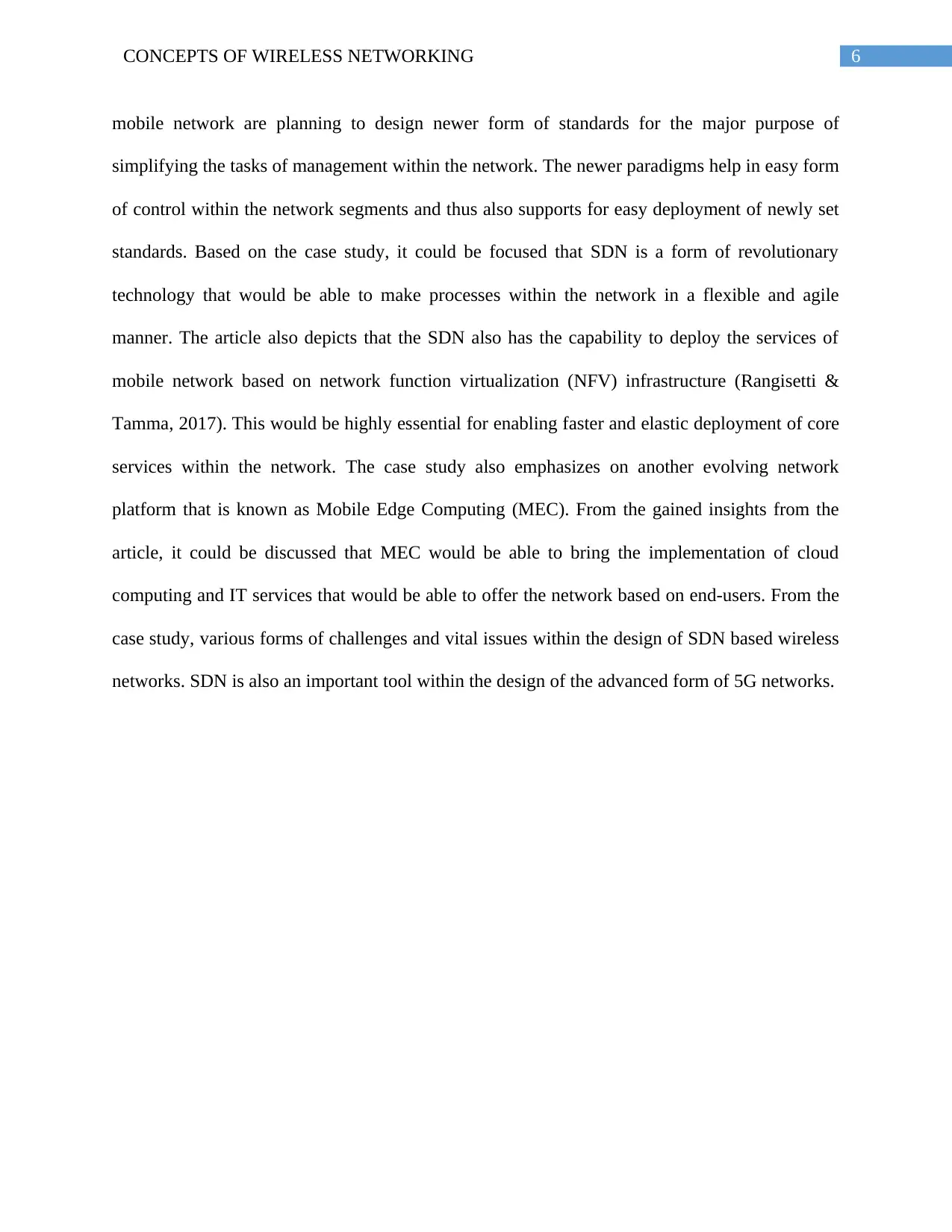
6CONCEPTS OF WIRELESS NETWORKING
mobile network are planning to design newer form of standards for the major purpose of
simplifying the tasks of management within the network. The newer paradigms help in easy form
of control within the network segments and thus also supports for easy deployment of newly set
standards. Based on the case study, it could be focused that SDN is a form of revolutionary
technology that would be able to make processes within the network in a flexible and agile
manner. The article also depicts that the SDN also has the capability to deploy the services of
mobile network based on network function virtualization (NFV) infrastructure (Rangisetti &
Tamma, 2017). This would be highly essential for enabling faster and elastic deployment of core
services within the network. The case study also emphasizes on another evolving network
platform that is known as Mobile Edge Computing (MEC). From the gained insights from the
article, it could be discussed that MEC would be able to bring the implementation of cloud
computing and IT services that would be able to offer the network based on end-users. From the
case study, various forms of challenges and vital issues within the design of SDN based wireless
networks. SDN is also an important tool within the design of the advanced form of 5G networks.
mobile network are planning to design newer form of standards for the major purpose of
simplifying the tasks of management within the network. The newer paradigms help in easy form
of control within the network segments and thus also supports for easy deployment of newly set
standards. Based on the case study, it could be focused that SDN is a form of revolutionary
technology that would be able to make processes within the network in a flexible and agile
manner. The article also depicts that the SDN also has the capability to deploy the services of
mobile network based on network function virtualization (NFV) infrastructure (Rangisetti &
Tamma, 2017). This would be highly essential for enabling faster and elastic deployment of core
services within the network. The case study also emphasizes on another evolving network
platform that is known as Mobile Edge Computing (MEC). From the gained insights from the
article, it could be discussed that MEC would be able to bring the implementation of cloud
computing and IT services that would be able to offer the network based on end-users. From the
case study, various forms of challenges and vital issues within the design of SDN based wireless
networks. SDN is also an important tool within the design of the advanced form of 5G networks.
Paraphrase This Document
Need a fresh take? Get an instant paraphrase of this document with our AI Paraphraser

7CONCEPTS OF WIRELESS NETWORKING
4. References
Bennis, M., Simsek, M., Czylwik, A., Saad, W., Valentin, S., & Debbah, M. (2013). When
cellular meets WiFi in wireless small cell networks. IEEE communications
magazine, 51(6), 44-50.
Bernardos, C. J., De La Oliva, A., Serrano, P., Banchs, A., Contreras, L. M., Jin, H., & Zúñiga, J.
C. (2014). An architecture for software defined wireless networking. IEEE wireless
communications, 21(3), 52-61.
Cihangir, A., Whittow, W. G., Panagamuwa, C. J., Ferrero, F., Jacquemod, G., Gianesello, F., &
Luxey, C. (2013). Feasibility study of 4G cellular antennas for eyewear communicating
devices. IEEE Antennas and Wireless Propagation Letters, 12, 1704-1707.
Dahlman, E., Parkvall, S., & Skold, J. (2013). 4G: LTE/LTE-advanced for mobile broadband.
Academic press.
Duarte, M., Sabharwal, A., Aggarwal, V., Jana, R., Ramakrishnan, K. K., Rice, C. W., &
Shankaranarayanan, N. K. (2014). Design and characterization of a full-duplex
multiantenna system for WiFi networks. IEEE Transactions on Vehicular
Technology, 63(3), 1160-1177.
Heydon, R. (2013). Bluetooth low energy: the developer's handbook (Vol. 1). Upper Saddle
River, NJ: Prentice Hall.
Pan, W., Huang, C., Chen, P., Pu, M., Ma, X., & Luo, X. (2013). A beam steering horn antenna
using active frequency selective surface. IEEE Transactions on Antennas and
Propagation, 61(12), 6218-6223.
4. References
Bennis, M., Simsek, M., Czylwik, A., Saad, W., Valentin, S., & Debbah, M. (2013). When
cellular meets WiFi in wireless small cell networks. IEEE communications
magazine, 51(6), 44-50.
Bernardos, C. J., De La Oliva, A., Serrano, P., Banchs, A., Contreras, L. M., Jin, H., & Zúñiga, J.
C. (2014). An architecture for software defined wireless networking. IEEE wireless
communications, 21(3), 52-61.
Cihangir, A., Whittow, W. G., Panagamuwa, C. J., Ferrero, F., Jacquemod, G., Gianesello, F., &
Luxey, C. (2013). Feasibility study of 4G cellular antennas for eyewear communicating
devices. IEEE Antennas and Wireless Propagation Letters, 12, 1704-1707.
Dahlman, E., Parkvall, S., & Skold, J. (2013). 4G: LTE/LTE-advanced for mobile broadband.
Academic press.
Duarte, M., Sabharwal, A., Aggarwal, V., Jana, R., Ramakrishnan, K. K., Rice, C. W., &
Shankaranarayanan, N. K. (2014). Design and characterization of a full-duplex
multiantenna system for WiFi networks. IEEE Transactions on Vehicular
Technology, 63(3), 1160-1177.
Heydon, R. (2013). Bluetooth low energy: the developer's handbook (Vol. 1). Upper Saddle
River, NJ: Prentice Hall.
Pan, W., Huang, C., Chen, P., Pu, M., Ma, X., & Luo, X. (2013). A beam steering horn antenna
using active frequency selective surface. IEEE Transactions on Antennas and
Propagation, 61(12), 6218-6223.

8CONCEPTS OF WIRELESS NETWORKING
Rangisetti, A. K., & Tamma, B. R. (2017). Software Defined Wireless Networks: A Survey of
Issues and Solutions. Wireless Personal Communications, 97(4), 6019-6053.
Wang, Y., Yang, X., Zhao, Y., Liu, Y., & Cuthbert, L. (2013, January). Bluetooth positioning
using RSSI and triangulation methods. In Consumer Communications and Networking
Conference (CCNC), 2013 IEEE (pp. 837-842). IEEE.
Wu, J., Zhao, Z., Nie, Z., & Liu, Q. H. (2014). Bandwidth enhancement of a planar printed
quasi-Yagi antenna with size reduction. IEEE Transactions on Antennas and
Propagation, 62(1), 463-467.
Rangisetti, A. K., & Tamma, B. R. (2017). Software Defined Wireless Networks: A Survey of
Issues and Solutions. Wireless Personal Communications, 97(4), 6019-6053.
Wang, Y., Yang, X., Zhao, Y., Liu, Y., & Cuthbert, L. (2013, January). Bluetooth positioning
using RSSI and triangulation methods. In Consumer Communications and Networking
Conference (CCNC), 2013 IEEE (pp. 837-842). IEEE.
Wu, J., Zhao, Z., Nie, Z., & Liu, Q. H. (2014). Bandwidth enhancement of a planar printed
quasi-Yagi antenna with size reduction. IEEE Transactions on Antennas and
Propagation, 62(1), 463-467.
⊘ This is a preview!⊘
Do you want full access?
Subscribe today to unlock all pages.

Trusted by 1+ million students worldwide
1 out of 9
Related Documents
Your All-in-One AI-Powered Toolkit for Academic Success.
+13062052269
info@desklib.com
Available 24*7 on WhatsApp / Email
![[object Object]](/_next/static/media/star-bottom.7253800d.svg)
Unlock your academic potential
Copyright © 2020–2025 A2Z Services. All Rights Reserved. Developed and managed by ZUCOL.




